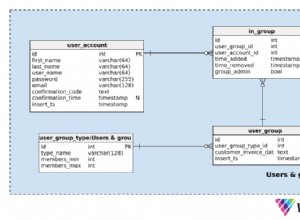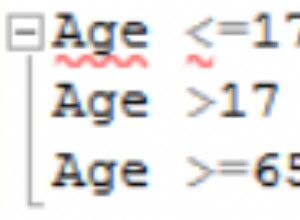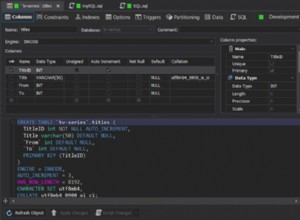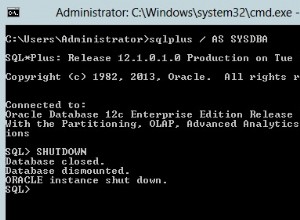Napisany przez Ciebie kod nie ma większego sensu; za dużo pobierania, które nie działa (dwie kolumny w jednej zmiennej?).
Oto przykład:tabela testowa:
SQL> create table test (email varchar2(30));
Table created.
SQL> insert into test
2 select '[email protected]' from dual union all
3 select '[email protected]' from dual union all
4 select '[email protected]' from dual union all
5 select '[email protected]' from dual;
4 rows created.
Jak oddzielić od niej część domeny (druga kolumna poniższego SELECT) i zaktualizować adresy e-mail do nowej domeny (kolumna trzecia):
SQL> select email,
2 substr(email, instr(email, '@') + 1) domain,
3 replace(email,
4 substr(email, instr(email, '@') + 1),
5 'new_domain.com'
6 ) result
7 from test;
EMAIL DOMAIN RESULT
------------------------- --------------- -------------------------
[email protected] hotmail.com [email protected]_domain.com
[email protected] net.hr [email protected]_domain.com
[email protected] gmail.com [email protected]_domain.com
[email protected] gmail.com [email protected]_domain.com
SQL>
Zaktualizujmy tylko adresy e-mail Gmaila do nowej domeny:
Zestaw testowy aktualizacjiSQL> update test set
2 email = replace(email,
3 substr(email, instr(email, '@') + 1),
4 'new_domain.com'
5 )
6 where substr(email, instr(email, '@') + 1) = 'gmail.com';
2 rows updated.
SQL> select * From test;
EMAIL
-------------------------
[email protected]
[email protected]
[email protected]_domain.com
[email protected]_domain.com
SQL>
Jeśli chcesz przekonwertować go na procedurę, nie ma problemu:
SQL> rollback;
Rollback complete.
SQL> create or replace procedure p_change_domain
2 (par_old_domain in varchar2,
3 par_new_domain in varchar2)
4 is
5 begin
6 update test set
7 email = replace(email,
8 substr(email, instr(email, '@') + 1),
9 par_new_domain
10 )
11 where substr(email, instr(email, '@') + 1) = par_old_domain;
12 end;
13 /
Procedure created.
SQL> exec p_change_domain('gmail.com', 'new_domain_2.com');
PL/SQL procedure successfully completed.
SQL> select * From test;
EMAIL
-------------------------
[email protected]
[email protected]
[email protected]_domain_2.com
[email protected]_domain_2.com
SQL>
Jeśli desperacko chcesz używać kursorów (nie wiem, dlaczego miałbyś to robić; będzie to prawdopodobnie najbardziej nieefektywna opcja), proszę bardzo:
SQL> rollback;
Rollback complete.
SQL> create or replace procedure p_change_domain
2 (par_old_domain in varchar2,
3 par_new_domain in varchar2)
4 is
5 begin
6 for cur_r in (select email from test
7 where substr(email, instr(email, '@') + 1) = par_old_domain
8 )
9 loop
10 update test set
11 email = replace(email,
12 substr(email, instr(email, '@') + 1),
13 par_new_domain
14 )
15 where email = cur_r.email;
16 end loop;
17 end;
18 /
Procedure created.
SQL> exec p_change_domain('gmail.com', 'new_domain_3.com');
PL/SQL procedure successfully completed.
SQL> select * From test;
EMAIL
-------------------------
[email protected]
[email protected]
[email protected]_domain_3.com
[email protected]_domain_3.com
SQL>
Pętla kursora FOR jest łatwiejsza w utrzymaniu niż twoja próba (tworzenie kursora i zmiennej kursora, otwieranie kursora, pobieranie z niego, dbanie o wyjście z pętli, zamykanie kursora).
Ale jeśli nie możesz bez tego żyć, proszę bardzo:
SQL> rollback;
Rollback complete.
SQL> create or replace procedure p_change_domain
2 (par_old_domain in varchar2,
3 par_new_domain in varchar2)
4 is
5 cursor c1 is
6 select email from test
7 where substr(email, instr(email, '@') + 1) = par_old_domain;
8 c1r c1%rowtype;
9 begin
10 open c1;
11 loop
12 fetch c1 into c1r;
13 exit when c1%notfound;
14
15 update test set
16 email = replace(email,
17 substr(email, instr(email, '@') + 1),
18 par_new_domain
19 )
20 where email = c1r.email;
21 end loop;
22 close c1;
23 end;
24 /
Procedure created.
SQL> exec p_change_domain('gmail.com', 'new_domain_4.com');
PL/SQL procedure successfully completed.
SQL> select * From test;
EMAIL
-------------------------
[email protected]
[email protected]
[email protected]_domain_4.com
[email protected]_domain_4.com
SQL>
Moja sugestia? Jeśli to możliwe, używaj czystego SQL. Albo pierwsza procedura PL/SQL. Nie używaj do tego kursorów.




